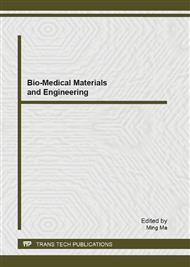p.283
p.289
p.293
p.299
p.304
p.309
p.318
p.322
p.328
Enantiomeric Separation of 1-Phenyl-1-Propanol Using Calix[4]Arene-Capped β-Cyclodextrin-Bonded Silica Particles as Chiral Stationary Phase in Capillary Electrochromatography
Abstract:
A new type of calix [ arene-capped (3-(2-O-β-cyclodextrin)-2-hydroxypropoxy) propylsilyl-appended silica particles (C4CD-HPS) has been successfully used as chiral stationary phase (CSP) in capillary electrochromatography (CEC) for separation of enantiomers of 1-phenyl-1-propanol for the first time. C4CD-HPS contains a chiral selector with two recognition sites: calix [arene and β-cyclodextrin. Due to the cooperative functioning of the calix [arene and β-cyclodextrin, C4CD-HPS has exhibited excellent enantioselectivity for the enantiomers of 1-phenyl-1-propanol. After the multiple phenolic hydroxyl groups in the calix [arene moieties are ionized in the running buffer, the bonded stationary phase C4CD-HPS becomes negatively-charged to provide high electroosmotic flow (EOF) in CEC. Fast and high-resolution separation for enantiomers of 1-phenyl-1-propanol has been easily achieved on C4CD-HPS. This new type of chiral stationary phase has exhibited great potential for fast enantiomeric separations in CEC.
Info:
Periodical:
Pages:
304-308
Citation:
Online since:
August 2013
Authors:
Price:
Сopyright:
© 2013 Trans Tech Publications Ltd. All Rights Reserved
Share:
Citation:


